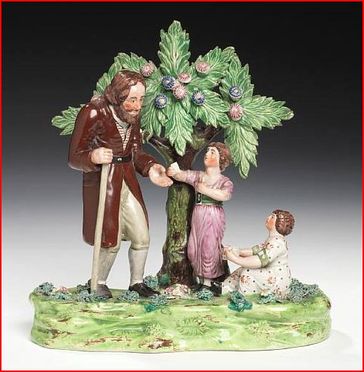As always, writing this blog teaches me what I don't know, but I do know that this figure group, which sold in London recently, is very very rare.
The group has probably been loved and enjoyed by that same owner because it only reappear on the market this month. Again, it has gone into a private collection, and I hope to be able to see it within the next year. So isn't the bocage superb? The subject may not be to everyone's taste, but the quality is yummy. The enamels are pretty-pretty, and the group is in totally orginal condition, with absolutely no repairs or restorations. And definitely rarer than either hen's teeth or a blue moon!
It is fabulously exciting when a unique figure group appears on the market. We all get a chance to look at it, and some lucky person becomes its custodian for the remainder of his or her days. Please remember to put your figures back on the market when you no longer need them. Figures languishing in museum storage or on the shelves of museums in remote locations just don't get the attention they deserve.
UPDATE
If you read the comment left by Kevin Lowe, you will note that he finds the frond on the base of this figure similar to one he has on a figure of Elijah. Perhaps the figures are from the same potbank....too early to tell with just one shared feature. The bocage on our alms group is unusual. I have found it on only a few other figures. .

This superb pearlware figure of St. Peter is in the Hanley Museum. The bocage is the same as that used on the alms group, above, and the enamels are similarly pretty. Both figures are reminiscent of wares marked WALTON. But many other potters made similar figures and as yet there is no basis for attributing either St. Peter or the alms group to Walton. Time may change that!














